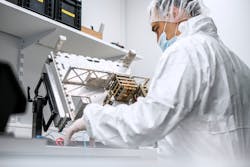NanoAvionics to launch its 5th satellite rideshare mission with new MP42 bus aboard SpaceX Transporter-4
BREMEN, Germany - Smallsat integrator NanoAvionics has announced its latest satellite rideshare mission “MP42” to be launched aboard a SpaceX Falcon 9 with payloads from OQ Technology and Veoware. Using the prototype of its new MP42 microsatellite bus, it is the fifth shared satellite mission by NanoAvionics, which has been one of the firsts companies in the nanosatellite industry to successfully kickstart and continue such a commercial program. The launch of NanoAvionics’ satellite has been booked for the SpaceX Transporter-4 mission, planned for 2022.
The MP42 is also the company’s largest built satellite yet and the first commercially available modular microsat bus in the industry. It has the same modularity for hard- and software and mission operations infrastructure as NanoAvionics’ nanosatellites. It will be deployed into low Earth orbit (LEO) via a launch agreement with NanoAvionics’ launch partner Exolaunch, a German company providing launch, deployment and in-space transportation services. Exolaunch will also supply its CarboNIX separation ring to dock the MP42 to the SpaceX port aboard its Falcon 9 rocket.
Among other customer payloads aboard the MP42, NanoAvionics will integrate a second ‘cell tower in space’, dubbed “Tiger-3”, for OQ Technology’s 5G IoT/M2M communication constellation. The microsatellite will also host Veoware’s RW500 fully integrated reaction wheel for high performance satellite attitude control with next-generation high torque / low power technology.
Vytenis J. Buzas, co-founder and CEO of NanoAvionics said: “With the MP42 platform as the latest addition to our product range of small satellites, we are enabling organizations to enter and benefit from the space market in the microsat segment. Previously, their use was constrained due to higher cost, lack of modularity, mechanical restraints and suitable mission operations. Our rideshare missions and shared satellite services have proven to be very beneficial to many NewSpace companies. They allowed them to quickly and cost efficiently demonstrate their technologies in orbit, and add further satellites to their constellations.”
OQ Technology’s third mission follows the successful launch of its Tiger-2 satellite in June this year, which performed very well during tests. Using the satellite, the company also tested its user terminal in harsh conditions and managed to achieve even indoor reach with no external antennas.
OQ’s ‘cell-tower in space’ technology aims to provide real-time global connectivity with ultra-reliable low latency communication (URLLC) and massive machine type communications (mMTC), compatible with the global 3GPP standard, for applications in rural and remote areas, particularly in industries such as oil, gas, logistics, mining and defense. The company has recently revealed its patents portfolio for 5G IoT cellular communication over satellites and aims to provide global coverage from north pole to south pole.
Omar Qaise, founder and CEO of OQ Technology said: “After our successful Tiger-1 and Tiger-2 missions, we are now accelerating the deployment of our satellite network to have global ‘cell tower in space’ coverage for 5G IoT applications. Tiger-3 will provide better access and more capacity to interested customers, and will soon be followed by more missions.”
Veoware will run various in-orbit tests with its RW500 high-torque reaction wheel. The reaction wheel is designed to offer high torque for low volume and low power consumption, with the greatest agility for satellites around 50 kg, and for missions with a minimum of five years lifetime. Other technological features include low magnetic residual, very high radiation shielding, redundant windings, firmware upgrades in space and regenerative braking.
The MP42 bus is part of NanoAvionics new range of microsats. It was developed by the company to meet the growing customer demand for hosting more sophisticated payloads like larger cameras for Earth observation or power-hungry devices for high data throughput and complex communications missions. The MP42 is capable of accommodating payloads in the range of 50 kg and all its subsystems were tested with 20kRad biased radiation dose and board level Single Event Effects (SEE) tested under 200 MeV Proton Beam, ensuring at least five years of lifetime in LEO.
As a default in its new microsat range, NanoAvionics introduced its upgraded payload controller to maximize data-exchange and support payload operations. The new range of microsat products will also include AI reinforced on-board payload data processing, maximized data exchange rates, and the possibility to implement customer software blocks similarly as in mobile phone application cases.
